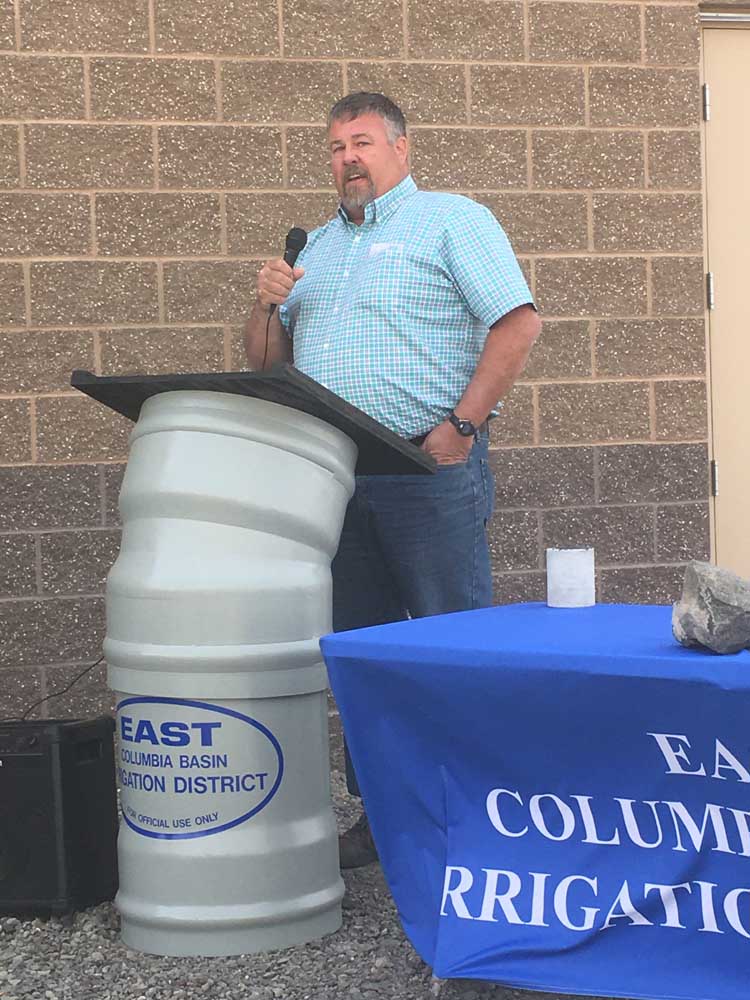Next three Odessa irrigation systems fully funded
Published 9:30 am Tuesday, November 7, 2023

- East Columbia Basin Irrigation District Manager Craig Simpson speaks during a ceremony May 27, 2021, for the new EL 47.5 delivery system, replacing declining well water with water from the Columbia Basin Project.
Nearly $70 million in federal and state funding means the next three Odessa Subarea irrigation systems are fully funded, conservation and irrigation districts say.
The Natural Resources Conservation Service Regional Conservation Partnership Program will provide:
• $13.1 million for the EL 80.6 mainline extension and on-farm buildouts.
• $19.7 million for the EL 84.7 mainline extension and on-farm buildouts.
• $7.2 million for the EL 86.4 on-farm buildouts, totaling $39.9 million.
State funds total $39.8 million through the state Department of Ecology’s Office of the Columbia River. The state legislature recently provided $32.8 million in appropriations, with $7 million from the past biennium.
The three southern Odessa Ground Water Replacement Program systems are now fully funded and able to move forward with construction.
“This is huge, this is unprecedented,” said Kristina Ribellia, executive director of the Columbia Basin Conservation District.
The three systems serve about 23 landowners and 18,426 acres of farmland, she said.
Those landowners now have cost-share for their on-farm buildouts, Ribellia said.
“Truly, from the canals through the laterals out to on-farm is fully funded,” she said. “It’s all systems go for those three lower systems.”
The three large-scale irrigation systems will provide Columbia River water to conserve approximately 55,278 acre-feet of water in the Odessa aquifer each year and replace approximately 18,426 acres of deep well irrigation, according to the conservation district and East Columbia Basin Irrigation District.
Beginning in 2024
The irrigation district hopes to start construction on all three systems in 2024, irrigation district secretary-manager Craig Simpson said.
“We’re in really good shape,” he said. “Designs are well over 60% on all of them, and the funding’s in place. Some of the big hurdles are out of the way, and now it’s down to surveys and all that stuff. … Those just take a little while.”
When the systems are running depends on easement acquisitions and material procurement, Simpson said.
He hopes to get water deliveries on the EL 86.4 system in 2024 because “there’s a lot less components on that because there’s no pump plant.”
The other two will likely deliver water in 2026, “but that’s depending on a bunch of things we don’t necessarily have control over,” he said.
The 47.5 system has been operational since 2021. Five more irrigation delivery systems are currently in the works, Simpson said.
Ribellia expects to pursue similar NRCS funding for the additional five systems. She said that state and other contributions provide a “critical” match.
‘Be aggressive’
When NRCS Chief Terry Cosby toured the Odessa Subarea in June, he told stakeholders to “be aggressive and to go big” seeking funding.
“That’s exactly what we did,” Ribellia said. Stakeholders submitted seven RCPP proposals.
“I had hoped they would fund at least three; I can’t believe they actually did,” she said. “It’s unheard of for any applicant to get more than one, and we got three.”
Ribellia believes the “dire” state of the aquifer makes the project stand out when seeking funding. Its decline threatens 26 communities in the Columbia Basin that use it for their drinking water supply.
“Basically, we’re in a state of emergency to try to conserve the remaining groundwater as quickly as we can,” she said. “Getting them on reliable Columbia River water as soon as possible is just critical.”
Fourteen partners contributed $42 million in cash and in-kind support to help ensure the success of the three awarded RCPP proposals.







